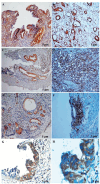Expression of inflammatory proteins STAT & NFĸB for phenotypic diagnosis of gall bladder cancer: A pilot study
- PMID: 40536380
- PMCID: PMC12178194
- DOI: 10.25259/IJMR_1461_2024
Expression of inflammatory proteins STAT & NFĸB for phenotypic diagnosis of gall bladder cancer: A pilot study
Abstract
Background & objectives Gallbladder cancer (GBC) has a low overall survival rate due to late detection and poor prognosis. Chronic inflammation contributes to malignant conversion and metastasis in GBC. Expression of inflammatory proteins, such as signal transducer and activator of transcription factor (STAT) and nuclear factor kappa B (NFĸB) proteins, for diagnosis through immunohistochemistry (IHC) is a promising area of research; however, diagnosis of GBC through IHC-based methods is still in its infancy. So, the present pilot study explores the use of STAT proteins (STAT 3 and 6) and NFĸB as diagnostic biomarkers for GBC. Methods Histologically confirmed cases of GBC (n=13) and cholelithiasis (n=23) as controls, were recruited. IHC was performed for protein expression of STAT3, STAT6, and NFĸB. Subgrouping into high and low expression was performed based on the receiver operating curve (ROC) analysis. Diagnostic utility and its association with the aggressiveness of cancer were assessed. Results The mean age of GBC and cholelithiasis patients was 50.84±14.5 and 44.0±11.9 years, respectively. Liver infiltration and metastasis were observed in 61 per cent and 69 per cent of the patients, respectively. STAT3, STAT6, and NFĸB expressions were significantly higher in GBC as compared to cholelithiasis. Sensitivity and specificity for STAT3 and STAT6 were 91, 47 and 75, 39 per cent, respectively. STAT6 expression was associated with lymph node involvement. Whereas, both STAT3 and STAT6 expressions were associated with Liver infiltration. Interpretation & conclusions This pilot study demonstrated STAT3 and STAT6 as sensitive and specific molecular biomarkers for diagnosing and assessing the aggressiveness of GBC. These may be used as an adjunct to the diagnosis of GBC after validation on a larger sample size.
Keywords: Chronic cholecystitis; NFĸB; STAT; gall bladder cancer (GBC); inflammatory proteins.
Conflict of interest statement
None.
Figures


References
-
- Mehrotra R, Tulsyan S, Hussain S, Mittal B, Singh Saluja S, Singh S, et al. Genetic landscape of gallbladder cancer: Global overview. Mutat Res Rev Mutat Res. 2018;778:61–7. - PubMed
-
- Mhatre S, Wang Z, Nagrani R, Badwe R, Chiplunkar S, Mittal B, et al. Common genetic variation and risk of gallbladder cancer in India: A case-control genome-wide association study. Lancet Oncol. 2017;18:535–44. - PubMed
-
- Shukla SK, Singh G, Shahi KS, Bhuvan N, Pant P. Staging, treatment, and future approaches of gallbladder carcinoma. J Gastrointest Cancer. 2018;49:9–15. - PubMed
MeSH terms
Substances
LinkOut - more resources
Full Text Sources
Medical
Research Materials
Miscellaneous

